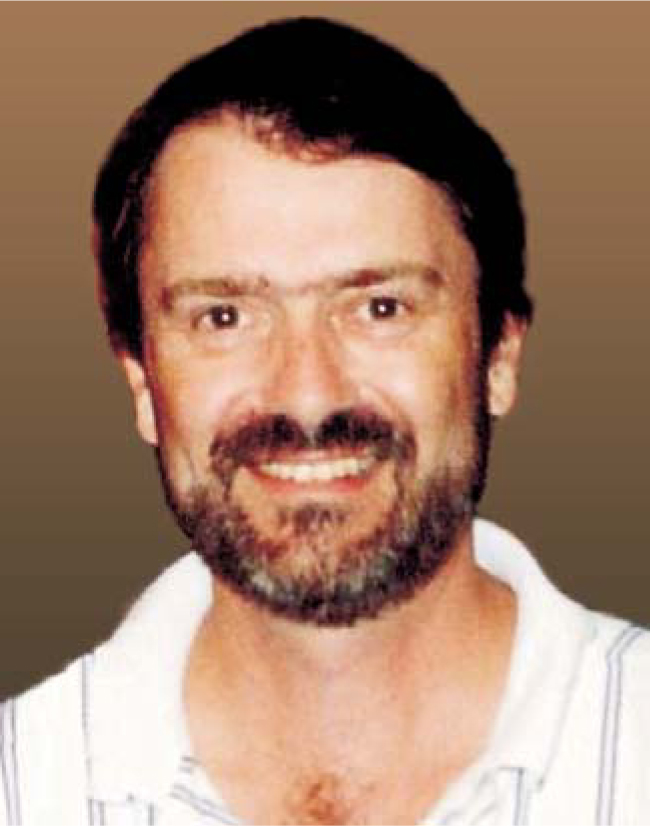Harry Louis Melanson
DOI: 10.1063/1.1881911
Harry Louis Melanson died on 17 April 2004 in Geneva, Illinois, after a short illness. A high-energy physicist with Fermilab, he carried out research involving the D-Zero experiment.
Born on 28 November 1956 in Washington, DC, Harry spent most of his early years in Maryland. He attended Michigan State University, where he received his BS in physics and computer science in 1978 and his PhD in high-energy physics in 1985. His thesis experiment (Fermilab E663), carried out in a group headed by one of us (Abolins), was designed to study reactions of pions, kaons, and antiprotons incident on a hydrogen target. The reaction products were analyzed using a downstream spectrometer. During his dissertation work on lambda and antilambda inclusive polarizations, he made important contributions to all aspects of the experiment, including the design of custom trigger electronics, data collection, and the writing of software to perform a long and detailed analysis of the recorded data. The quality of his thesis reflected his rare intelligence and mature physics judgment.
After receiving his degree, Harry joined Fermilab, where he met his future wife, physicist Cat James. He first worked on the deep inelastic muon scattering experiment (E665). Drawing on his training in computer science, he wrote much of the experiment’s core software, including the data acquisition and online programs, pattern recognition for track finding, event display, and the summary data format. Much of what he did started out as solutions targeted at relatively small tasks, but his strong, solid approach led to their becoming models that were extended to most or all of the other systems in the experiment.
Harry’s scientific legacy on E665 includes the first measurement of jets in deep inelastic scattering—an analysis shepherded from an original idea to publication in Physical Review Letters in 1992—and precision measurements of proton and deuteron structure functions. He enjoyed mentoring many students and postdoctoral researchers on the project and continued to be a mentor throughout his tenure on Fermilab’s scientific staff. His work in developing software that allowed physicists to analyze data easily has influenced other experiments now carried out by his former students and postdocs.
Harry moved to the collider experiment D-Zero in 1992. After its first run, he led the group on electroweak physics, which produced one of the world’s most precise measurements of the W boson’s mass. He contributed greatly to the development of software for event simulation, reconstruction, and analysis. Two years before his death, he became the software and algorithm coordinator and was responsible for all the offline software in the experiment.
Still, his D-Zero colleagues remember him best not for his technical achievements but for his quiet good sense and intellectual leadership. They could count on Harry to keep the collaboration on a sensible path and to serve as an excellent sounding board for ideas and plans. People found him pleasant to interact with, perhaps because he had the gift of actually listening to what was said and because he was instinctively supportive—never competitive.
Over the years, Harry served on various Fermilab committees associated with hiring and tenure, including as chair of the committee on scientific appointments in 2002 to 2003. One of his particular concerns was the support and mentoring of younger physicists. A strong and enthusiastic advocate of the postdoctoral researchers at D-Zero, Harry had a special bond with them. He frequently was one of the first faces they saw during their job interview. Harry also was a continuing source of able advice and support—and tolerance for opinions different from his—on subjects as diverse as physics, skiing, golf, and space travel.
We miss his guidance and friendship.


More about the Authors
Maris Abolins. Michigan State University, East Lansing, US.
Heidi Schellman. Northwestern University, Evanston, Illinois, US.
Petros Rapidis. Fermi National Accelerator Laboratory, Batavia, Illinois, US.
Linda Stutte. Fermi National Accelerator Laboratory, Batavia, Illinois, US.
John Womersley. Fermi National Accelerator Laboratory, Batavia, Illinois, US.
